Photodimerization of (E)-3-(2,6-Difluorophenyl)-1-(4-methoxyphenyl)prop-2-en-1-one in the Crystalline Solid State
Abstract
1. Introduction
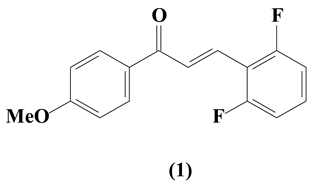
2. Results and Discussion
2.1. Synthesis and Spectroscopic Characterization of Chalcone 1
2.2. Characterization of Chalcone 1 by X-ray Crystallography
2.3. Photochemical Reaction
3. Materials and Methods
3.1. Photodimerization Reaction
3.2. X-ray Crystallography
4. Conclusions
Supplementary Materials
Author Contributions
Funding
Data Availability Statement
Acknowledgments
Conflicts of Interest
References
- Ávila, H.P.; Smânia, E.F.A.; Monache, F.D.; Smânia Júnior, A. Structure–activity relationship of antibacterial chalcones. Bioorg. Med. Chem. 2008, 16, 9790–9794. [Google Scholar] [CrossRef] [PubMed]
- Bukhari, S.N.A.; Jasamai, M.; Jantan, I.; Ahmad, W. Review of methods and various catalysts used for chalcone synthesis. Mini-Rev. Org. Chem. 2013, 10, 73–83. [Google Scholar] [CrossRef]
- Chopra, P.K.P.G. Chalcones: A brief review. Int. J. Res. Eng. Appl. Sci. 2016, 6, 173–185. [Google Scholar]
- Wang, S.; Yu, G.; Lu, J.; Xiao, K.; Hu, Y.; Hu, H. A Regioselective Tandem reaction between chalcones and 2-acetamido-acetamide promoted by Cs2CO3 for the preparation of 33-unsubstituted 2-pyridones. Synthesis 2003, 487, 487–490. [Google Scholar]
- Chawla, H.M.; Chibber, S.S.; Chakrabarty, K. Daphnetin from Euphorbia dracunculoides fruits. Ind. J. Pharm. Sci. 1980, 42, 138–139. [Google Scholar]
- Chawla, H.M.; Chaudhuri, K. Chemical components of Cassia javanica leaves. Ind. J. Pharm. Sci. 1985, 47, 172–173. [Google Scholar]
- Rajnarayana, K.; Sripal Reddy, M.; Chaluvadi, M.R.; Krishna, D.R. Biflavonoids Classification, Pharmacological, Biochemical Effects and Therapheutic Potential. Indian J. Pharmacol. 2001, 33, 2–16. [Google Scholar]
- Matsushima, R.; Hirao, I. Photocyclization of 2′-Hydroxychalcones to 4-Flavanones. Bull. Chem. Soc. Jpn. 1980, 53, 518–520. [Google Scholar] [CrossRef]
- Miquel, J.F. Chimie Organic-Isomerie cis-trans des Styrylcetones et 2′hidroxychalcones. Compt. Rend. Hebd. Séances Acad. Sci. 1962, 254, 4479. [Google Scholar]
- Cioffi, G.; Escobar, L.M.; Braca, A.; Tommasi, N.D. Antioxidant Chalcone Glycosides and Flavanones from Maclura (Chlorophora) tinctoria. J. Nat. Prod. 2003, 66, 1061–1064. [Google Scholar] [CrossRef]
- Nakamura, Y.; Watanabe, S.; Miyake, N.; Kohno, H.; Osawa, T. Dihydrochalcones: Evaluation as novel radical scavenging antioxidants. J. Agric. Food Chem. 2003, 51, 3309–3312. [Google Scholar] [CrossRef] [PubMed]
- Herencia, F.; Ferrandiz, M.L.; Ubeda, A.; Guille, I.; Dominguez, J.N.; Charris, J.E.; Gricela, M.; Lobo, M.; Alcaraz, J. Novel anti-inflammatory chalcone derivatives inhibit the induction of nitric oxide synthase and cyclooxygenase-2 in mouse peritoneal macrophages. FEBS Lett. 1999, 453, 129–134. [Google Scholar] [CrossRef] [PubMed]
- Reddy, M.V.B.; Su, C.-R.; Chiou, W.-F.; Liu, Y.-N.; Chen, R.Y.-H.; Bastow, K.F.; Lee, K.-H.; Wu, T.-S. Design, synthesis, and biological evaluation of Mannich bases of heterocyclic chalcone analogs as cytotoxic agents. Bioorg. Med. Chem. Lett. 2008, 16, 7358–7370. [Google Scholar] [CrossRef] [PubMed]
- Dimmock, J.R.; Elias, D.W.; Beazely, M.A.; Kandepu, N.M. Bioactivities of chalcones. Curr. Med. Chem. 1999, 6, 1125–1149. [Google Scholar] [CrossRef] [PubMed]
- Go, M.L.; Wu, X.; Liu, X.L. Chalcones: An update on cytotoxic and chemoprotective properties. Curr. Med. Chem. 2005, 12, 483–499. [Google Scholar] [CrossRef] [PubMed]
- Ni, L.; Meng, C.Q.; Sikorski, J.A. Recent advances in therapeutic chalcones. Expert Opin. Ther. Pat. 2004, 14, 1669–1691. [Google Scholar] [CrossRef]
- Yit, C.C.; Das, N.P. Cytotoxic effect of butein on human colon adenocarcinoma cell proliferation. Cancer Lett. 1994, 82, 65–72. [Google Scholar] [CrossRef]
- Ramanathan, R.; Tan, C.H.; Das, N.P. Cytotoxic effect of plant polyphenols and fat-soluble vitamins on malignant human cultured cells. Cancer Lett. 1992, 62, 217–224. [Google Scholar] [CrossRef]
- Bowden, K.; Dalpozzo, A.D.; Duah, C.K. Structure-Activity. Part 5. Antibacterial Activity of Substituted (E)-3-(4-Phenylbenzoyl)acrylic Acids, Chalcones, 2- hydroxychalcones and-α-Bromochalcones; Addition of Cysteine to Substituted 3-Benzoylacrylic Acids and Related Compounds. J. Chem. Res. 1990, 377. [Google Scholar]
- Wilhelm, A.; Bonnet, S.L.; Twigge, L.; Rarova, L.; Stenclova, T.; Visser, H.G.; Schutte-Smith, M. Synthesis, characterization and cytotoxic evaluation of chalcone derivatives. J. Mol. Struct. 2022, 1251, 132001. [Google Scholar] [CrossRef]
- Iwata, S.; Nishino, T.; Nagata, N.; Satomi, Y.; Nishino, H.; Shibata, S. Atitumorigenic Activitties of Chalcones. I. Inhibitory Effects of Chalcone Derivatives on Pi-Incorporation into phospholipdis of HeLa Cells Promoted by 12-O-Tetradecanoyl-phorbol 13-Acetate (TPA). Biol. Pharm. Bull. 1995, 18, 1710–1713. [Google Scholar] [CrossRef] [PubMed]
- Hu, C.Q.; Chen, K.; Shi, Q.; Kilkuskie, R.E.; Cheng, Y.C.; Lee, K.H. Anti-aids agents, 10. Acacetin-7-O-β-D-galactopyranoside, an anti-HIV principle from Chrysanthemum morifolium and a structure-activity correlation with some related flavonoids. J. Nat. Prod. 1994, 57, 42–51. [Google Scholar] [CrossRef] [PubMed]
- Li, R.; Kenyon, G.L.; Cohen, F.E.; Chem, X.; Gong, B.; Miller, R.E.; Nuzum, E.O.; Resenthal, P.J.; McKerrow, J.H. In Vitro Antimalarial Activity of Chalcones and Their Derivatives. J. Med. Chem. 1995, 38, 5031–5037. [Google Scholar] [CrossRef] [PubMed]
- Boeck, P.; Bandeira-Falcão, C.A.; Leal, P.C.; Yunes, R.A.; Filho, V.C.; Torres-Santos, E.C. Synthesis of chalcone analogues with increased antileishmanial activity. Bioorg. Med. Chem. 2006, 14, 1538–1545. [Google Scholar] [CrossRef] [PubMed]
- Lunardi, F.; Guzela, M.; Rodrigues, A.T.; Correa, R.; Mangrich, I.E.; Steindel, M.; Grisard, E.C.; Assreuy, J.; Calixto, J.B.; Santos, A.R.S. Trypanocidal and Leishmanicidal Properties of Substitution-Containing Chalcones. Antimicrob. Agents Chemother. 2003, 47, 1449–1451. [Google Scholar] [CrossRef]
- López, S.N.; Castelli, M.A.V.; Zacchino, S.A.; Dominguez, J.N.; Lobo, G.; Charris-Charris, J.; Cortes, J.C.G.; Ribas, J.C.; Devia, C.; Rodriguez, A.M.; et al. In Vitro Antifungal Evaluation and Structure–Activity Relationships of a New Series of Chalcone Derivatives and Synthetic Analogues, with Inhibitory Properties against Polymers of the Fungal Cell Wall. Bioorg. Med. Chem. 2001, 9, 1999–2013. [Google Scholar] [CrossRef]
- Alias, Y.; Awang, K.; Hadi, A.; Thoison, O.; Sevent, T.; Pais, M. An Antimitotic and Cytotoxic chalcone from Fissitigma Lanuginosum. J. Nat. Prod. 1995, 58, 1160. [Google Scholar] [CrossRef]
- Lawrence, N.J.; Patterson, R.P.; Ooi, L.L.; Cook, D.; Ducki, S. Effects of α- substitutions on structure and biological activity of anticancer chalcones. Bioorg. Med. Chem. Lett. 2006, 16, 5844–5848. [Google Scholar] [CrossRef]
- Rojas, J.; Paya, M.; Dominguez, J.N.; Ferrandiz, L.M. The Synthesis and Effect of Fluorinated Chalcone Derivatives on Nitric Oxide Production. Bioorg. Med. Chem. Lett. 2002, 12, 1951–1954. [Google Scholar] [CrossRef]
- Rojas, J.; Paya, M.; Dominguez, J.N.; Ferrandiz, L.M. ttCH, a selective inhibitor of inducible nitric oxide synthase expression with antiarthritic properties. Eur. J. Pharmacol. 2003, 465, 183–189. [Google Scholar] [CrossRef]
- Wu, J.; Wang, C.; Cai, Y.; Peng, J.; Liang, D.; Zhao, Y.; Yang, S.; Li, X.; Wu, X.; Liang, G. Synthesis and crystal structure of chalcones as well as on cytotoxicity and antibacterial properties. Med. Chem. Res. 2012, 21, 444–452. [Google Scholar] [CrossRef]
- Wu, P.; Yan, H.; Qi, J.; Jia, W.; Zhang, W.; Yao, D.; Ding, C.; Zhang, Y.; Chen, M.; Cai, X. L6H9 attenuates LPS-induced acute lung injury in rats through targeting MD2. Drug Dev. Res. 2020, 81, 85–92. [Google Scholar] [CrossRef] [PubMed]
- Sumneang, N.; Apaijai, N.; Chattipakorn, S.C.; Chattipakorn, N. Myeloid differentiation factor 2 in the heart: Bench to bedside evidence for potential clinical benefits? Pharmacol. Res. 2021, 163, 105239. [Google Scholar] [CrossRef] [PubMed]
- Aksöz, B.E.; Ertan, R. Chemical and structural properties of chalcones I. J. Pharm. Sci. 2011, 36, 223–242. [Google Scholar]
- Aksöz, B.E.; Ertan, R. Chemical and structural properties of chalcones II. J. Pharm. Sci. 2012, 37, 205–216. [Google Scholar]
- Rabinovich, D.; Schmidt, G.M.J. Topochemistry. Part XXIX. Crystal and molecular structures of p-methoxychalcone. J. Chem. Soc. B 1970, 6–10. [Google Scholar] [CrossRef]
- Green, B.S.; Schmidt, G.M.J. Topochemically-controlled solid-state photodimerization to a tricyclo [6.2.0.0.3,6]-decane derivative. Tetrahedron Lett. 1970, 11, 4249–4256. [Google Scholar] [CrossRef]
- Abdelmoty, I.; Buchholz, V.; Di, L.; Guo, C.; Kowitz, K.; Enkelmann, V.; Wegner, G.; Foxman, B.M. Polymorphism of Cinnamic and r-Truxillic Acids: New Additions to an Old Story. Cryst. Growth Des. 2005, 5, 2210–2217. [Google Scholar] [CrossRef]
- Atkinson, S.D.M.; Almond, M.J.; Hollins, P.; Jenkins, S.L. The photodimerisation of the α-and β-forms of trans-cinnamic acid: A study of single crystals by vibrational microspectroscopy. Spectrochim. Acta A 2003, 59, 629–635. [Google Scholar] [CrossRef]
- Gnanaguru, K.; Ramasubbu, N.; Venkatesan, K.; Ramamurthy, V. A study on the photochemical dimerization of coumarins in the solid state. J. Org. Chem. 1985, 50, 2337–2346. [Google Scholar] [CrossRef]
- Dihurjati, M.S.K.; Sarma, J.A.R.P.; Desiraju, G.R. Unusual [2 + 2] topochemical cycloadditions of 3-cyano- and 4-cyano-cinnamic acids: Temperature dependent solid state photochemical reactions. J. Chem. Soc. Chem. Commun. 1991, 1702–1703. [Google Scholar] [CrossRef]
- Caccamese, S.; McMillan, J.A.; Montaudo, G. Revision of the stereochemical assignment of a cyclobutane derivative from chalcone photodimerization via X-ray diffraction analysis. J. Org. Chem. 1978, 43, 2703–2704. [Google Scholar] [CrossRef]
- Montaudo, G.; Caccamese, S. Structure and conformation of chalcone photodimers and related compounds. J. Org. Chem. 1973, 38, 710–716. [Google Scholar] [CrossRef]
- Toda, F. Solid state organic chemistry: Efficient reactions, remarkable yields, and stereoselectivity. Acc. Chem. Res. 1995, 28, 480–486. [Google Scholar] [CrossRef]
- Schmidt, G.M.J. Photodimerization in the Solid State. Pure Appl. Chem. 1971, 27, 647–678. [Google Scholar] [CrossRef]
- Bart, J.C.J.; Schmidt, G.M.J. Topochemistry. Part XXXIII. The Solid-State Photochemistry of Some Anthracene Derivatives. Isr. J. Chem. 1971, 9, 429–448. [Google Scholar] [CrossRef]
- Venugopalan, P.; Rao, T.B.; Vengatesan, K. Studies in crystal engineering. Photochemical and crystallographic investigations of bromocoumarins and (±)-7-(p-bromobenzylidene)piperitone. J. Chem. Soc. Perkin Trans. 2 1991, 981–987. [Google Scholar] [CrossRef]
- Shu, Y.; Ye, K.; Yue, Y.; Sun, J.; Wang, H.; Zhong, J.; Yang, X.; Gao, H.; Lu, R. Fluorine as a robust balancer for tuning the reactivity of topo-photoreactions of chalcones crystals. Cryst. Eng. Comm. 2021, 23, 5856–5868. [Google Scholar] [CrossRef]
- Cesarin-Sobrinho, D.; Netto-Ferreira, J.C. Photochemistry of Fluorinated Chalcones in the Solid State. Quim. Nova 2002, 25, 62–68. [Google Scholar] [CrossRef]
- Lei, T.; Zhou, C.; Huang, M.-Y.; Zhao, L.-M.; Yang, B.; Ye, C.; Xiao, H.; Meng, Q.-Y.; Ramamurthy, V.; Tung, C.-H.; et al. General and Efficient Intermolecular [2+2] of Chalcones and Cinnamic Acid Derivatives in Solution through Visible Light Catalysis. Angew. Chem. Int. Ed. 2017, 56, 15407–15410. [Google Scholar] [CrossRef]
- Stewart, D.; Robertson, G.W.; Morrison, I.M. Identification of Cyclobutane-type Dimers of Substituted Cinnamic Acids by Gas Chromatography/Mass Spectrometry. Rapid Commun. Mass Spectrom. 1992, 6, 46–53. [Google Scholar] [CrossRef]
- Kohler, E.P.; Chadwell, H.M. Organic Syntheses Collective; John Wiley: New York, NY, USA, 1932; Volume I, p. 78. [Google Scholar]
- Cunha, S. Simple methods of single crystal formation of organic substance for structural study by X-ray diffraction. Quim. Nova 2008, 31, 906–909. [Google Scholar] [CrossRef]
- Duisenberg, A.J.M. Indexing in single crystal diffractometry with an obstinate list of reflections. J. Appl. Cryst. 1992, 25, 92–96. [Google Scholar] [CrossRef]
- Duisenberg, A.J.M.; Hooft, R.W.W.; Schreurs, A.M.M.; Kroon, J. Accurate cells from area-detector images. J. Appl. Cryst. 2000, 33, 893–898. [Google Scholar] [CrossRef]
- Farrugia, L.J. ORTEP-3 for Windows-a version of ORTEP-III with a Graphical User Interface (GUI). J. Appl. Cryst. 1997, 30, 565. [Google Scholar] [CrossRef]
- Farrugia, L.J. WinGX suite for small-molecule single-crystal crystallography. J. Appl. Cryst. 1999, 32, 837–838. [Google Scholar] [CrossRef]
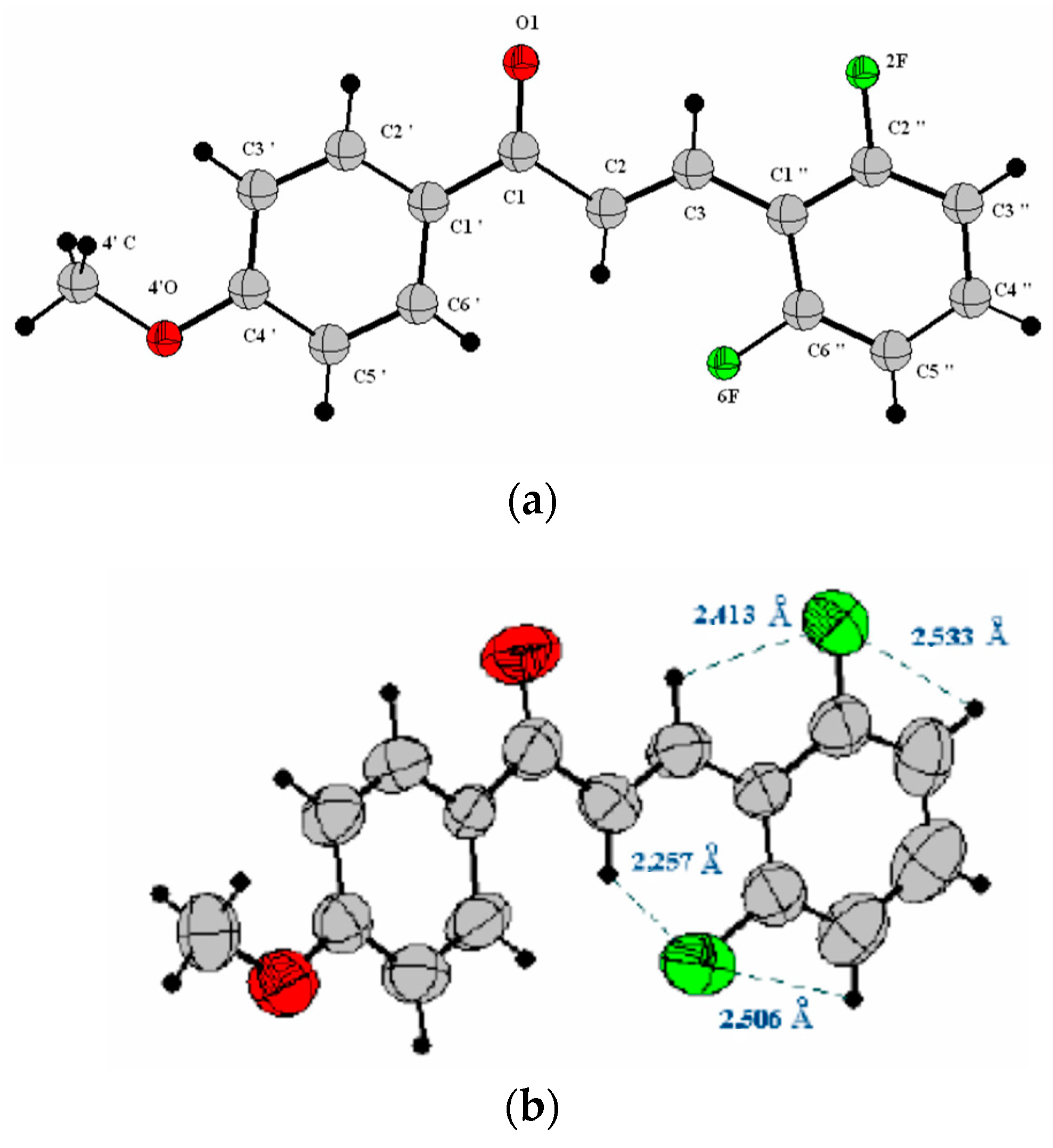
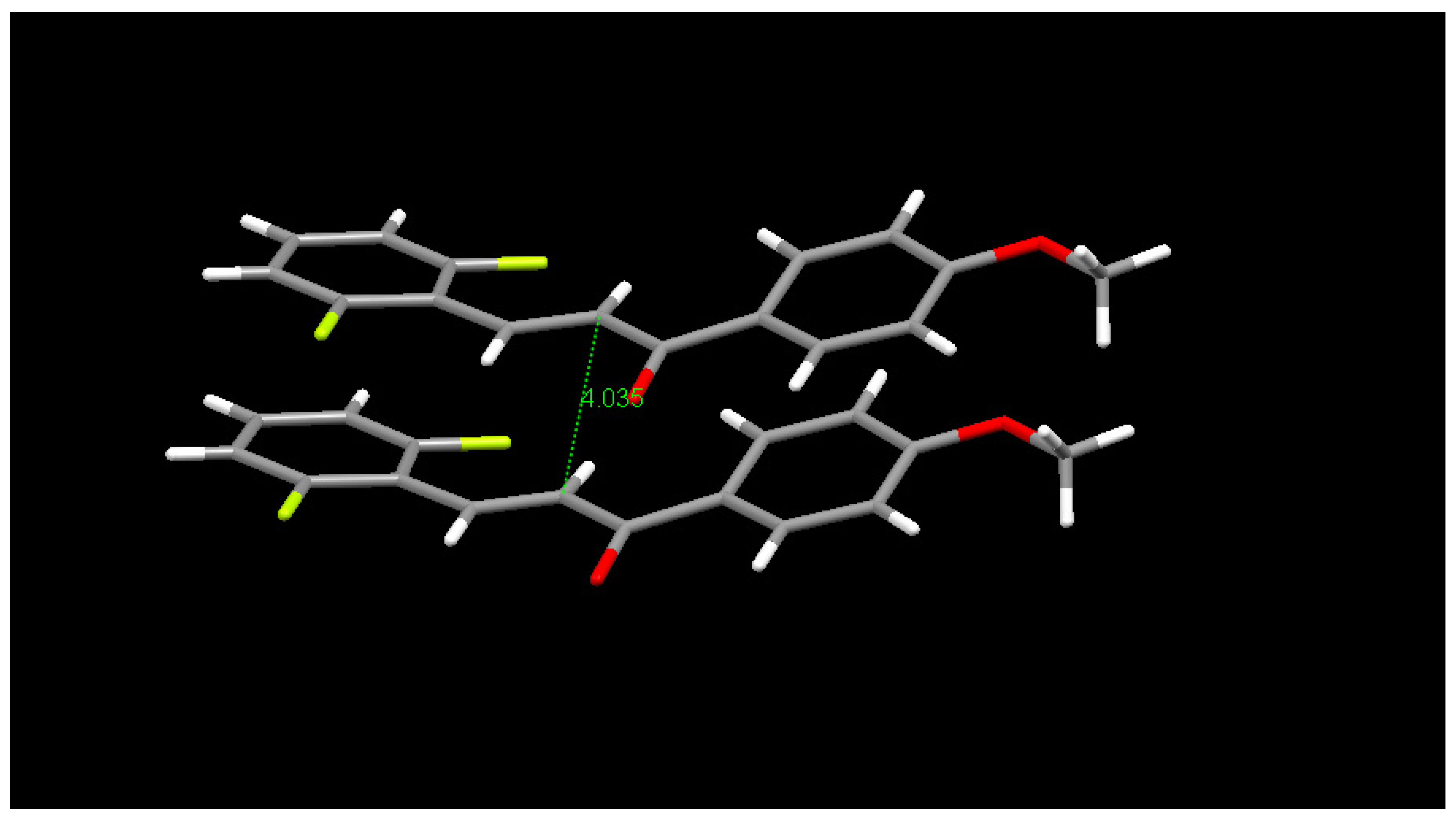
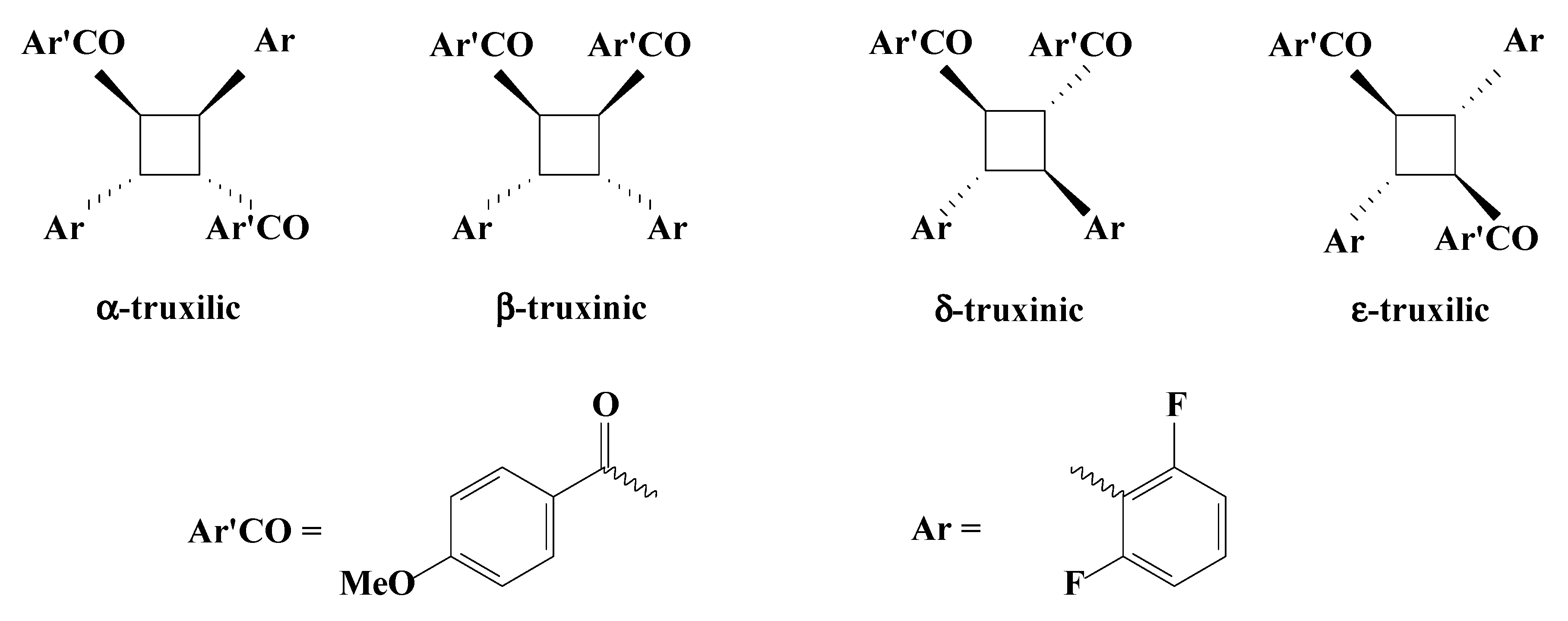
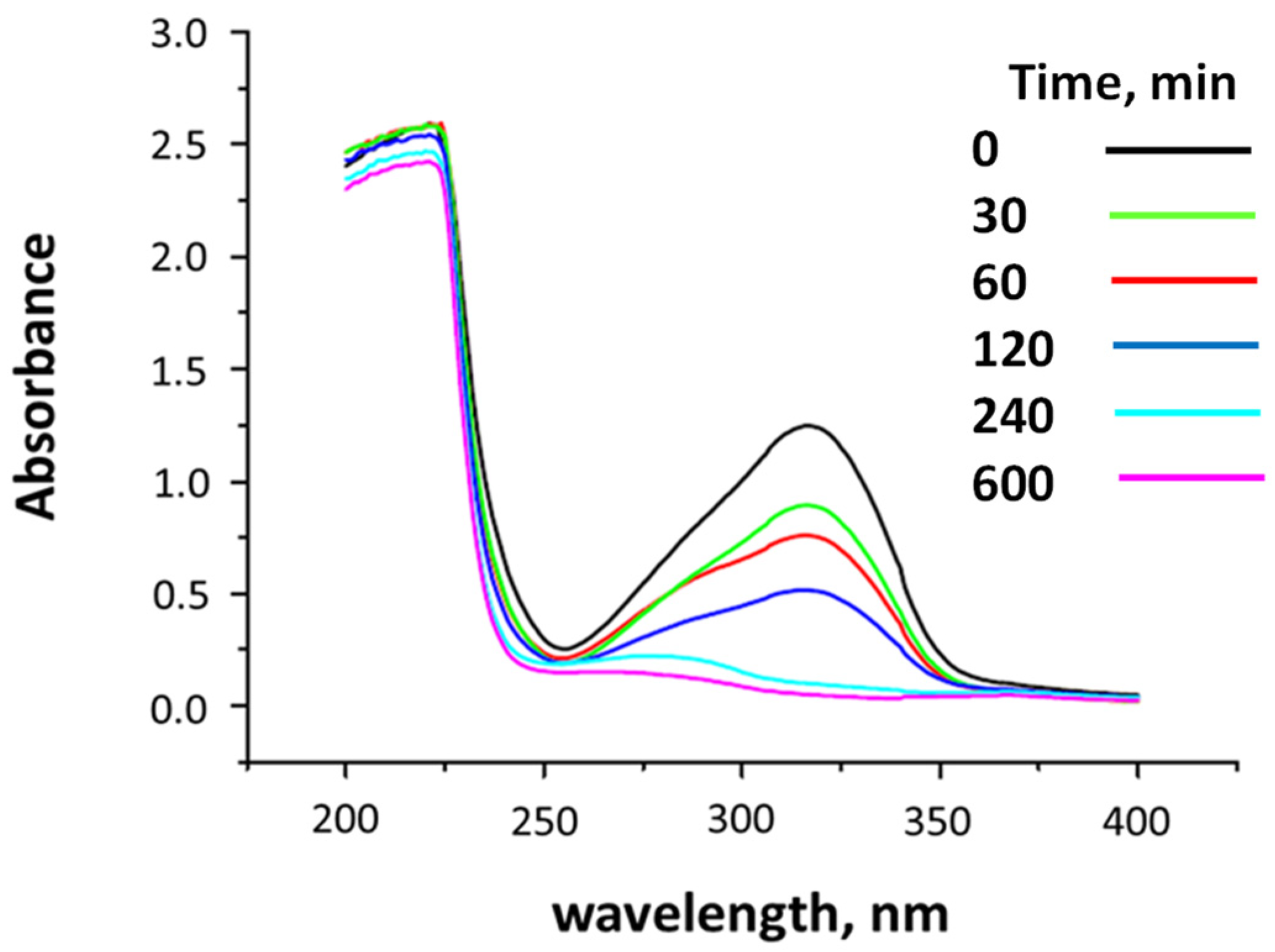
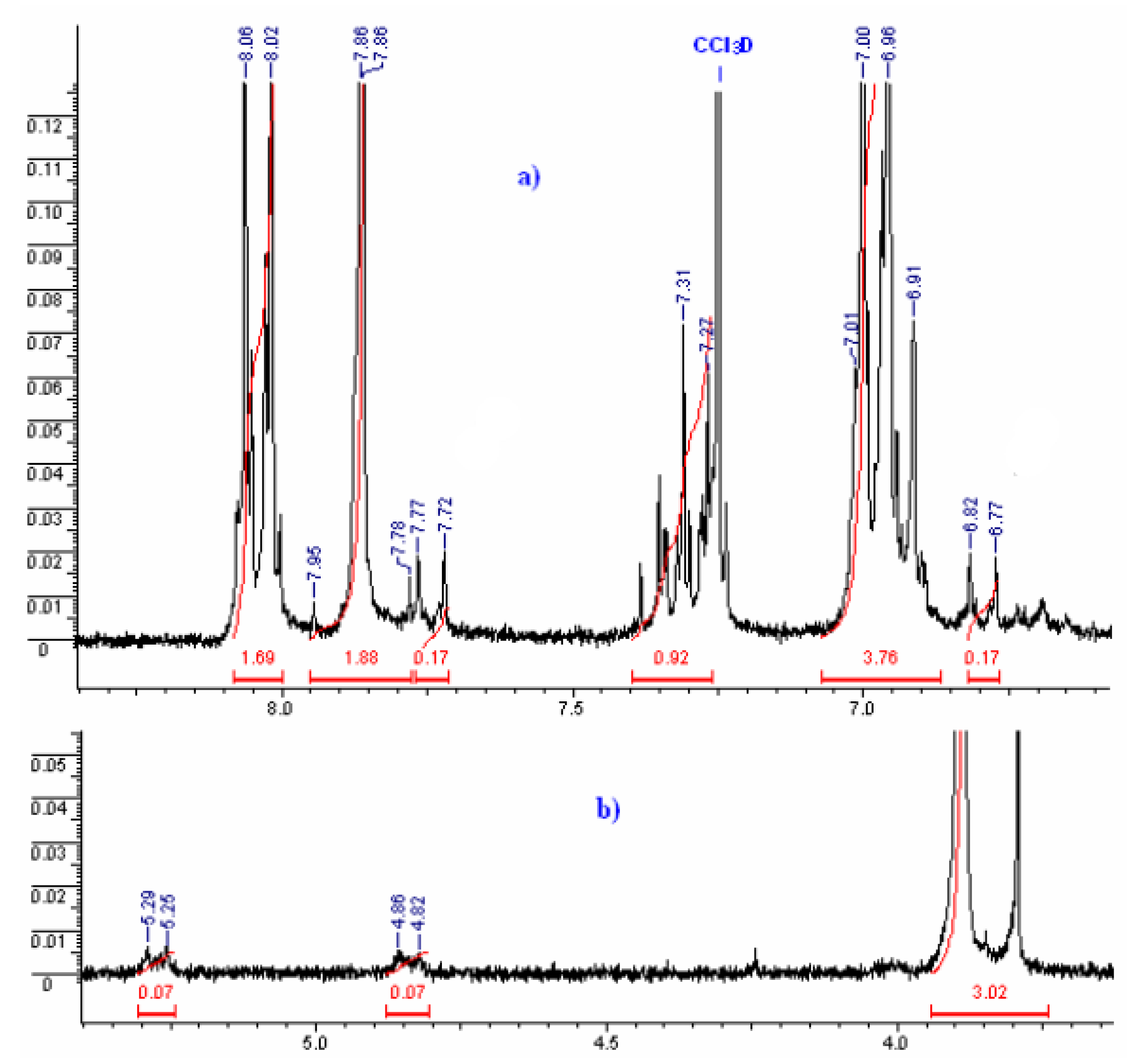
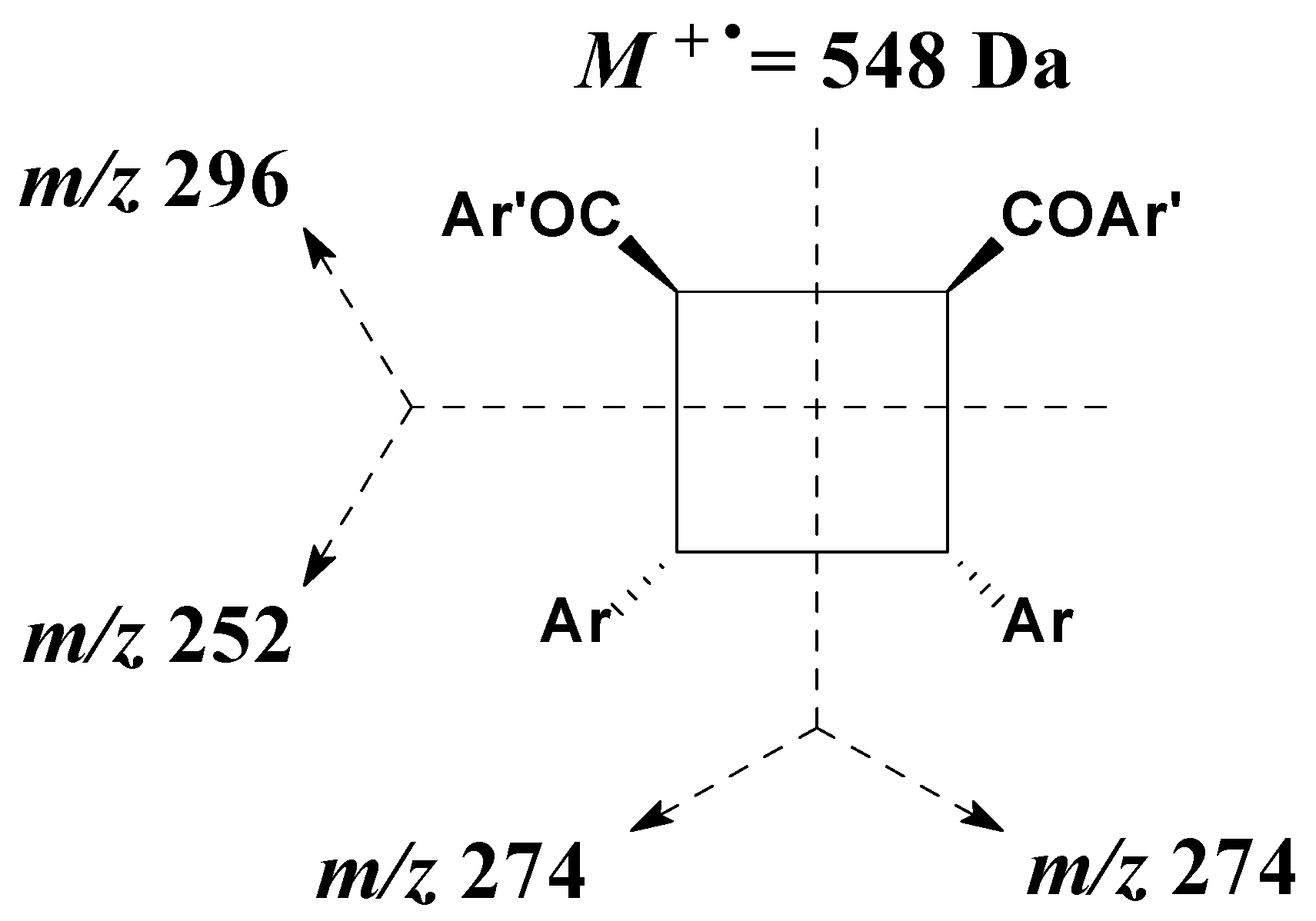


Disclaimer/Publisher’s Note: The statements, opinions and data contained in all publications are solely those of the individual author(s) and contributor(s) and not of MDPI and/or the editor(s). MDPI and/or the editor(s) disclaim responsibility for any injury to people or property resulting from any ideas, methods, instructions or products referred to in the content. |
© 2023 by the authors. Licensee MDPI, Basel, Switzerland. This article is an open access article distributed under the terms and conditions of the Creative Commons Attribution (CC BY) license (https://creativecommons.org/licenses/by/4.0/).
Share and Cite
de Paula, A.F.; Cesarin-Sobrinho, D.; Netto-Ferreira, J.C. Photodimerization of (E)-3-(2,6-Difluorophenyl)-1-(4-methoxyphenyl)prop-2-en-1-one in the Crystalline Solid State. Molbank 2023, 2023, M1609. https://doi.org/10.3390/M1609
de Paula AF, Cesarin-Sobrinho D, Netto-Ferreira JC. Photodimerization of (E)-3-(2,6-Difluorophenyl)-1-(4-methoxyphenyl)prop-2-en-1-one in the Crystalline Solid State. Molbank. 2023; 2023(2):M1609. https://doi.org/10.3390/M1609
Chicago/Turabian Stylede Paula, Adriano Farias, Dari Cesarin-Sobrinho, and José Carlos Netto-Ferreira. 2023. "Photodimerization of (E)-3-(2,6-Difluorophenyl)-1-(4-methoxyphenyl)prop-2-en-1-one in the Crystalline Solid State" Molbank 2023, no. 2: M1609. https://doi.org/10.3390/M1609
APA Stylede Paula, A. F., Cesarin-Sobrinho, D., & Netto-Ferreira, J. C. (2023). Photodimerization of (E)-3-(2,6-Difluorophenyl)-1-(4-methoxyphenyl)prop-2-en-1-one in the Crystalline Solid State. Molbank, 2023(2), M1609. https://doi.org/10.3390/M1609




